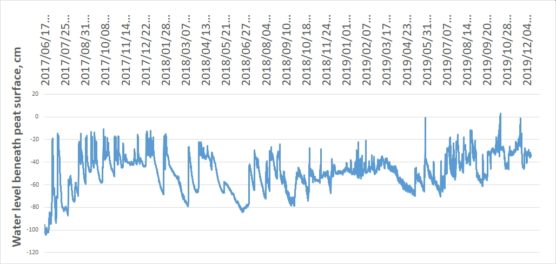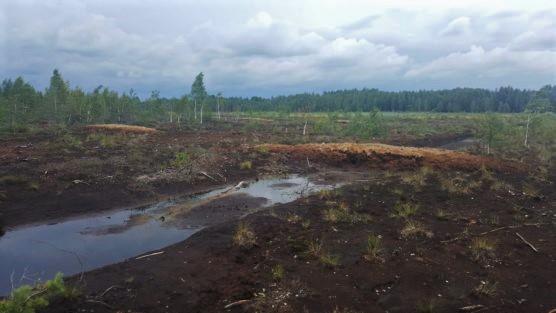Do you know that Madagascar, Switzerland and Sachara are in Lithuania? In fact, the first two sites represent the names of settlements, whereas peatland in North-Eastern Lithuania is named after the biggest desert in the world – Sachara. Unfortunately, these two sites have something in common. Both are suffering from the lack of water.
“Peatlands must be wet: for the climate, for the people, for the future”. These are the words of famous scientist and initiator of peatland restoration in Europe, professor at Greifswald University Prof. Dr. Hans Joosten. In order to preserve biodiversity and reduce greenhouse gas emissions, the Lithuanian Fund for Nature is restoring peatlands damaged by drainage and peat mining. For this purpose, in February, restoration actions based on approved nature management plan in Sachara peatland were started. These actions include tree cutting and damming of drainage ditches. Peatland is being restored in cooperation with the State Forest Enterprise and the Directorate of Sartai and Gražutė Regional Parks.
Sachara peatland is a valuable slowly recovering wildlife ecosystem in Rokiškis district (North-Eastern Lithuania). Stories tell us about a fire in the nearby Panemunėlis forest a century ago, which reached the peatland. The fire was burning even during the winter season. The wind was blowing ashes and dry peat just like sand. Thus, the local foresters named the area Sachara. This 88 ha site has been abandoned for more than 40 years. Over several decades, the peatland ecosystem has slowly begun to recover, but spontaneous self-regeneration process is disturbed by a network of still-functioning drainage systems. Despite long-term drainage and disturbance, the peatland is still able to maintain some natural values, including three types of habitats of EU importance. Moreover, based on the proposal of the Lithuanian Fund for Nature, the site has been included into NATURA 2000 network, in 2018.


All together 30 ha of forest (mainly birches and pines), which causes evapotranspiration of vital water and thus negatively effects the peatland, will be cleared. These actions are carried out by the Lithuanian Fund for Nature and the State Forest Enterprise (Rokiškis subunit) under the Trilateral Cooperation Agreement. The implementation of the works is supervised by the Sartai and Gražutė Regional Park Directorate, which is responsible for the conservation status of Sachara peatland. Harvested timber will be removed from the peatland, but some of the “waste wood“ will be laid directly into drainage ditches and thus will serve as substrate for Sphagnum moss colonization.

International and local experience shows that ditch blocking along with tree cutting is the best way not only to ensure stable water level, but to stop peat mineralization and reduce greenhouse gas emissions as well. Moreover, these actions contribute to the improvement of habitats, particularly for the rare bird and insect species, which are closely depended on the open bog habitats.

Nature management actions have already begun. To improve hydrological conditions, three embankments with water outflow constructions and 200 dams (peat, plastic planks, mixed construction) will be installed. Ditch blocking will be performed by the company, which already has the experience in this kind of projects – “Anykščių melioracija”. Tree cuttings and ditch blocking is strictly performed only in the protected area. Therefore, landowners in the adjacent areas should not be afraid of possible negative impact.



